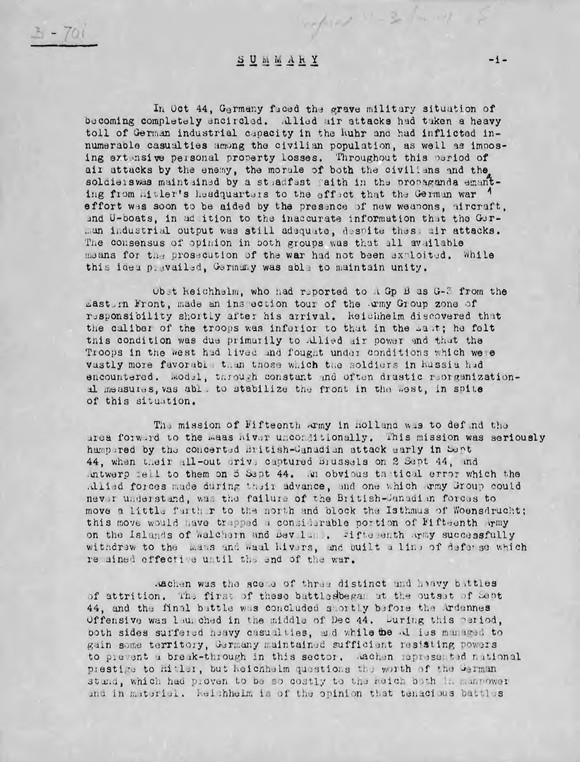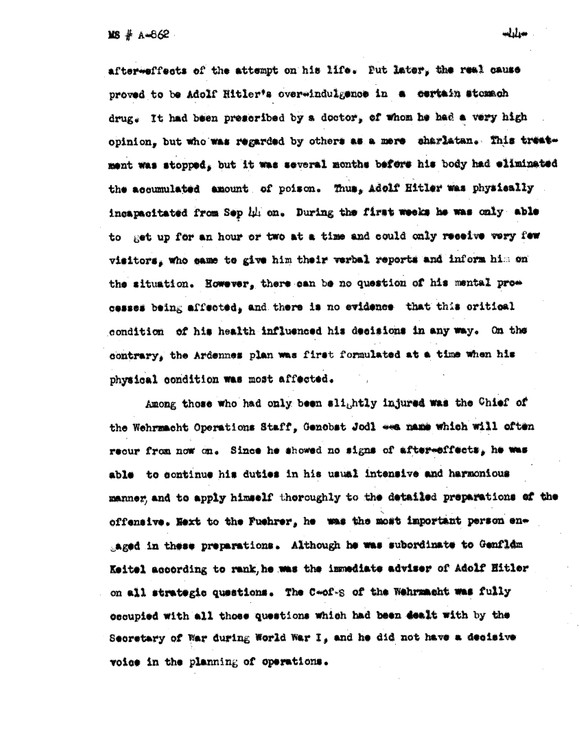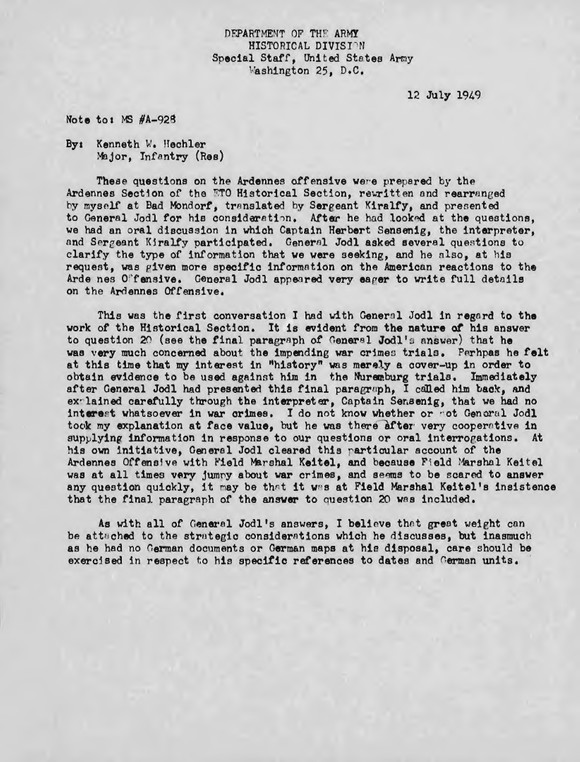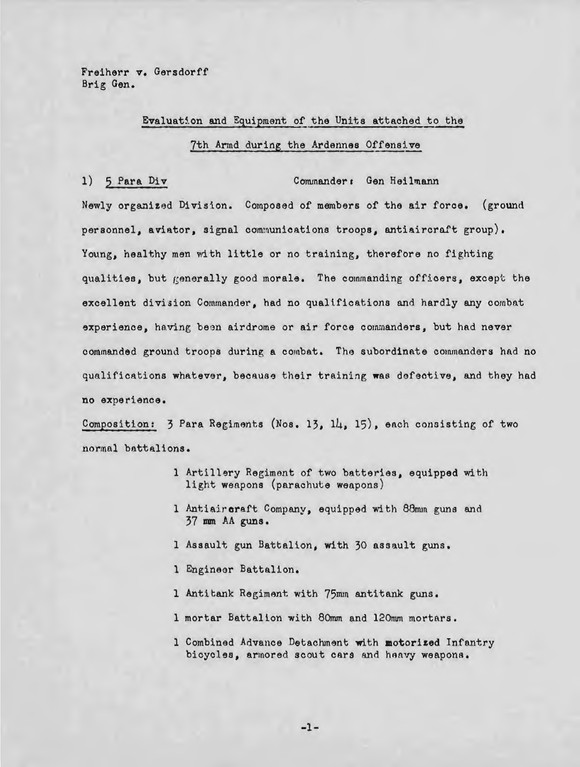Starting from:
$12.95
Home
World War II
World War II Battle of the Bulge (Ardennes Offensive) German Commanders Interrogatories and Reports
World War II Battle of the Bulge (Ardennes Offensive) German Commanders Interrogatories and Reports
World War II Battle of the Bulge (Ardennes Offensive) German Commanders Interrogatories and Reports
1,175 pages of manuscripts in the form of answers to U.S. Army questionnaires and reports from 19 German commanders, many who lead German forces during the Adriene’s Offensive, known to Americans as the Battle of the Bulge. They were completed between 1945 and 1947.
After World War II the U.S. Army had many German generals write World War II operational studies, first in the 1940's as POWs and then later in the 1950's as employees.
The reports in this collection covers the course of events of the German Offensive in the Ardennes (16 Dec 1944 — 14 Jan 1945).
Includes information by:
Wilhelm Keitel (1882–1946) Chief of the Armed Forces High Command of Germany during World War II. Keitel signed a number of criminal orders and directives that led to a war of unprecedented brutality and criminality.
Alfred Jodl (1890–1946) Chief of the Operations Staff for the Armed Forces High Command.
On July 20, 1945 Jodl was presented with twenty questions about the offensive. Jodl's answers were reviewed by Keitel. Among the information covered were reasons for the attack, training for the attack, radio intelligence, deception measures, fuel supply, weather and the effect of air power on the outcome of the Battle of the Bulge.
Later both Keitel and Jodl were indicted by the International Military Tribunal in Nuremberg. Keitel was found guilty on all counts of his indictment: crimes against humanity, crimes against peace, criminal conspiracy, and war crimes. Jodl was found guilty of all his charges: conspiracy to commit crimes against peace; planning, initiating and waging wars of aggression; war crimes; and crimes against humanity. They were both executed on 16 October 1946.
Major Percy Ernst Schramm (1894-1970) who kept the war diary of the Wehrmacht Operations Staff. He was able to give accounts of the German course of events of the German Offensive. Also details of Command organization for the Ardennes offensive. Schram was able to relate how the characteristics of Adolf Hitler effected the execution of the offensive and his rationales during the Battle of the Bulge.
Schramm was the official staff historian, or diarist, for the German High Command Operational Staff (Wehrmachtführungsstab), replacing Helmuth Greiner. In 1944, Schramm's sister-in-law was executed because of her active opposition to the Nazi regime, and accusations against Schramm himself, doubting his reliability, became known to Hitler's headquarters. However, these were ignored by General Alfred Jodl, Schramm's superior, and the historian was able to continue in his role as war diarist.
Because of his knowledge of the High Command, Schramm was called as a key witness at the Nuremberg Trials after the war, where he testified on behalf of Jodl. Schramm maintained that Jodl, while a loyal soldier, was not an ideological Nazi and did not participate in any war crimes. Jodl was convicted and hanged in 1946
Siegfried von Waldenburg (1898–1973) was a general in the Wehrmacht of Nazi Germany during World War II who commanded the 116th Panzer Division.
Rudolf Christoph Freiherr von Gersdorff (1905–1980) General and Chief of Staff of the German 7th Army. He participated in 3 plots to assassinate Hitler, although all 3 failed, his involvement went undetected. Gersdorff was able to give information about the offensive's history, operational plans, deceptions, operations and the conclusion of the Battle of the Bulge.
Franz Heinrich Otto Sensfuss (1891-1976) Generalleutnant Franz Sensfuss leader of the 212th Volks Grenadier Division. This division was the recomposition of the 272nd Infantry Division which suffered heavy losses at Normandy. Added were airmen and sailors retasked to infantry duties and given six weeks of training before being sent to the Western front to participate in the offensive. The new volksgrenadier division structure featured a smaller division size of 10,000 soldiers opposed to the regular 16,000. They made use of the new assault rifle model 1944 (Sturmgewehr 44) instead of the bolt action Mauser model 98 rifle. The volksgrenadier divisions were supposed to be the new model division representing the will of the German people, or das Volk, and their willingness to fight to the bitter end.
The element of surprise did well for this division at first. During the Battle of Kesternich from 13 to 18 December 1944, when it managed to encircle and reduce an entire battalion from the 310th Infantry Regiment of the U.S. 78th Infantry Division, capturing over 300 men and officers. The division could not maintain that level of performance and was destroyed in the April 1945 Battle of the Ruhr Pocket.
Most other volksgrenadier divisions had greater failure and the volksgrenadier concept fell far short of German expectations. To the Allies by the end of the war, the term volksgrenadier came to mean second-rate, bottom-of-the-barrel type of soldier.
Carl Wagener (1901–1988) commander of the Fifth Panzer Army. Wagener concentrated on reasons for the failure of the Ardennes offensive. He cited speedy counter measures by the Americans after the surprise attack, bad training of motorized units, traffic jams on roads and bad morale.
Erich Brandenberger (1892-1955) General der Panzertruppe Erich Brandenberger lead the German Seventh Army in the Ardennes. The 7th Army's role during the offensive was to guard the southern flank of the Fifth Panzer Army and suffered severe losses inflicted by the U.S. Army's 3rd Army during General George S. Patton's drive to Bastogne and Houffalize.
Diepold Georg Heinrich Freiherr von Lüttwitz (1896–1969) General der Panzertruppe (General of the Armored Corps) Heinrich von Luettwitz describes the operations of the XLVII Panzer Corps.
Hans Felber (1889–1962) General der Infanterie Hans Felber commander of the Corps Group Felber covered defensive fighting in the Ardennes
Generalmajor Walter Denkert (1897–1982) commander of the 3rd Panzer Grenadier Division writes about the reconditioning of troops near the frontlines.
Walter Staudinger - Generalleutnant Walter Staudinger commander of the Sixth SS Panzer Army Artillery wrote about its role in the Ardennes offensive.
Guenther Reichhelm - German Army Group B's Oberst Reichhelm's summary of engagements in the West, with background information on the Ardennes offensive; includes a character sketch of Field Marshal Modell.
Gerhard Engel (1906 – 1976) - A report by Generalleutnant Gerhard Engel describes the battles of the 12th Infantry Division during the Ardennes Offensive until 29 December 1944.
Generalstabsoffizier Hans-Juergen Dingier - Hans-Juergen Dingier chief of staff of LVIII Panzer Corps describes campaigns in Northern France, the Rhineland, and the Ardennes.
Others include:
Karl Thoholte (1893-1954) General der Artillerie commander Army Group B Artillery.
Eugen Walter Krüger (1892–1973) General der Panzertruppen commander of the LVIII Panzer Corps
Walter Lucht (1882 – 1949) General der Artillerie of the LXVI Corps
Otto Hitzfeld - General der Infanterie Otto Kitz-feld of the LXIV Armeekorps
General der Panzertruppen Heinrich von Luettwitz commander of the XLVII Panzer Corps
Generalleutnant Fritz Bayerlein commander of the Panzer Lehr Division
Herbert Buechs, Air Corps Aide to General Jodl
Generalmajor Walter Denkert, Commander of the 3d Panzer Grenadier Division
Generalmajor Erwin Kaschner commander of the 326th Volksgrenadier-Division
Werner Bodenstein Corps chief of staff LIII Corps
Generalmajor Paul Riedel of the German Seventh Army Artillery








1,175 pages of manuscripts in the form of answers to U.S. Army questionnaires and reports from 19 German commanders, many who lead German forces during the Adriene’s Offensive, known to Americans as the Battle of the Bulge. They were completed between 1945 and 1947.
After World War II the U.S. Army had many German generals write World War II operational studies, first in the 1940's as POWs and then later in the 1950's as employees.
The reports in this collection covers the course of events of the German Offensive in the Ardennes (16 Dec 1944 — 14 Jan 1945).
Includes information by:
Wilhelm Keitel (1882–1946) Chief of the Armed Forces High Command of Germany during World War II. Keitel signed a number of criminal orders and directives that led to a war of unprecedented brutality and criminality.
Alfred Jodl (1890–1946) Chief of the Operations Staff for the Armed Forces High Command.
On July 20, 1945 Jodl was presented with twenty questions about the offensive. Jodl's answers were reviewed by Keitel. Among the information covered were reasons for the attack, training for the attack, radio intelligence, deception measures, fuel supply, weather and the effect of air power on the outcome of the Battle of the Bulge.
Later both Keitel and Jodl were indicted by the International Military Tribunal in Nuremberg. Keitel was found guilty on all counts of his indictment: crimes against humanity, crimes against peace, criminal conspiracy, and war crimes. Jodl was found guilty of all his charges: conspiracy to commit crimes against peace; planning, initiating and waging wars of aggression; war crimes; and crimes against humanity. They were both executed on 16 October 1946.
Major Percy Ernst Schramm (1894-1970) who kept the war diary of the Wehrmacht Operations Staff. He was able to give accounts of the German course of events of the German Offensive. Also details of Command organization for the Ardennes offensive. Schram was able to relate how the characteristics of Adolf Hitler effected the execution of the offensive and his rationales during the Battle of the Bulge.
Schramm was the official staff historian, or diarist, for the German High Command Operational Staff (Wehrmachtführungsstab), replacing Helmuth Greiner. In 1944, Schramm's sister-in-law was executed because of her active opposition to the Nazi regime, and accusations against Schramm himself, doubting his reliability, became known to Hitler's headquarters. However, these were ignored by General Alfred Jodl, Schramm's superior, and the historian was able to continue in his role as war diarist.
Because of his knowledge of the High Command, Schramm was called as a key witness at the Nuremberg Trials after the war, where he testified on behalf of Jodl. Schramm maintained that Jodl, while a loyal soldier, was not an ideological Nazi and did not participate in any war crimes. Jodl was convicted and hanged in 1946
Siegfried von Waldenburg (1898–1973) was a general in the Wehrmacht of Nazi Germany during World War II who commanded the 116th Panzer Division.
Rudolf Christoph Freiherr von Gersdorff (1905–1980) General and Chief of Staff of the German 7th Army. He participated in 3 plots to assassinate Hitler, although all 3 failed, his involvement went undetected. Gersdorff was able to give information about the offensive's history, operational plans, deceptions, operations and the conclusion of the Battle of the Bulge.
Franz Heinrich Otto Sensfuss (1891-1976) Generalleutnant Franz Sensfuss leader of the 212th Volks Grenadier Division. This division was the recomposition of the 272nd Infantry Division which suffered heavy losses at Normandy. Added were airmen and sailors retasked to infantry duties and given six weeks of training before being sent to the Western front to participate in the offensive. The new volksgrenadier division structure featured a smaller division size of 10,000 soldiers opposed to the regular 16,000. They made use of the new assault rifle model 1944 (Sturmgewehr 44) instead of the bolt action Mauser model 98 rifle. The volksgrenadier divisions were supposed to be the new model division representing the will of the German people, or das Volk, and their willingness to fight to the bitter end.
The element of surprise did well for this division at first. During the Battle of Kesternich from 13 to 18 December 1944, when it managed to encircle and reduce an entire battalion from the 310th Infantry Regiment of the U.S. 78th Infantry Division, capturing over 300 men and officers. The division could not maintain that level of performance and was destroyed in the April 1945 Battle of the Ruhr Pocket.
Most other volksgrenadier divisions had greater failure and the volksgrenadier concept fell far short of German expectations. To the Allies by the end of the war, the term volksgrenadier came to mean second-rate, bottom-of-the-barrel type of soldier.
Carl Wagener (1901–1988) commander of the Fifth Panzer Army. Wagener concentrated on reasons for the failure of the Ardennes offensive. He cited speedy counter measures by the Americans after the surprise attack, bad training of motorized units, traffic jams on roads and bad morale.
Erich Brandenberger (1892-1955) General der Panzertruppe Erich Brandenberger lead the German Seventh Army in the Ardennes. The 7th Army's role during the offensive was to guard the southern flank of the Fifth Panzer Army and suffered severe losses inflicted by the U.S. Army's 3rd Army during General George S. Patton's drive to Bastogne and Houffalize.
Diepold Georg Heinrich Freiherr von Lüttwitz (1896–1969) General der Panzertruppe (General of the Armored Corps) Heinrich von Luettwitz describes the operations of the XLVII Panzer Corps.
Hans Felber (1889–1962) General der Infanterie Hans Felber commander of the Corps Group Felber covered defensive fighting in the Ardennes
Generalmajor Walter Denkert (1897–1982) commander of the 3rd Panzer Grenadier Division writes about the reconditioning of troops near the frontlines.
Walter Staudinger - Generalleutnant Walter Staudinger commander of the Sixth SS Panzer Army Artillery wrote about its role in the Ardennes offensive.
Guenther Reichhelm - German Army Group B's Oberst Reichhelm's summary of engagements in the West, with background information on the Ardennes offensive; includes a character sketch of Field Marshal Modell.
Gerhard Engel (1906 – 1976) - A report by Generalleutnant Gerhard Engel describes the battles of the 12th Infantry Division during the Ardennes Offensive until 29 December 1944.
Generalstabsoffizier Hans-Juergen Dingier - Hans-Juergen Dingier chief of staff of LVIII Panzer Corps describes campaigns in Northern France, the Rhineland, and the Ardennes.
Others include:
Karl Thoholte (1893-1954) General der Artillerie commander Army Group B Artillery.
Eugen Walter Krüger (1892–1973) General der Panzertruppen commander of the LVIII Panzer Corps
Walter Lucht (1882 – 1949) General der Artillerie of the LXVI Corps
Otto Hitzfeld - General der Infanterie Otto Kitz-feld of the LXIV Armeekorps
General der Panzertruppen Heinrich von Luettwitz commander of the XLVII Panzer Corps
Generalleutnant Fritz Bayerlein commander of the Panzer Lehr Division
Herbert Buechs, Air Corps Aide to General Jodl
Generalmajor Walter Denkert, Commander of the 3d Panzer Grenadier Division
Generalmajor Erwin Kaschner commander of the 326th Volksgrenadier-Division
Werner Bodenstein Corps chief of staff LIII Corps
Generalmajor Paul Riedel of the German Seventh Army Artillery








1 file (113.0MB)



